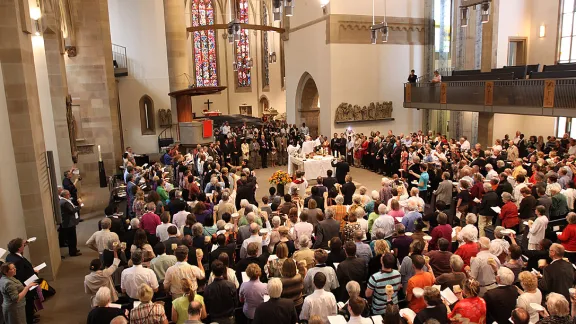
Eucharistic service at the LWF Eleventh Assembly 2010 in Stuttgart, Germany. Photo: LWF/J. Latva-Hakuni
Survey Shows 72 Million Members
(LWI) – Member churches of The Lutheran World Federation (LWF) are growing, statistics gathered by the LWF Communion Office show.
According to the data, the 142 LWF member churches, 10 recognized congregations and 2 recognized councils in 79 countries had a combined total of 72,268,329 members as of February 2014, showing a slight increase of 2.1 percent since statistics were last gathered in 2011. The total number of member churches changes to 142 (140 members and 2 associate member churches) due to mergers in Germany and Estonia.
The growing numbers of members in LWF churches can mostly be attributed to the African and Asian regions. In Africa the survey shows an increase of 3 percent or 600,000 people. In Asia statistics show an increase of 1.7 million Lutherans in LWF member churches since 2011.
Member churches in the Latin American/Caribbean, European and North American regions continued a slow decrease in membership, most notably in North America (7.8 percent) and Europe (1.6 percent), while in Latin America and the Caribbean membership dropped by 0.3 percent, amounting to about 2,300 people in total.
Some of the more obvious changes in membership figures can be attributed to church mergers and different ways of compiling membership figures. The Andhra Evangelical Lutheran Church (AELC) in India, which reported an increase of 212 percent over 2011, did a more thorough update of its membership figures than it had in previous years, thereby effectively including the growth in its membership over more than just the last two years.
Due to new data protection laws in some areas of Switzerland the statistics show a decrease of almost one half. It is assumed that not all LWF members have been reported and that the actual number of Swiss Lutherans might be almost twice the reported figure.
Membership figures reported from Rwanda also show a decrease by almost 90 percent. This is related to the 1994 genocide when the Lutheran Church of Rwanda (LCR) set up church tents for people displaced by the conflict. The worshippers who registered included Christians of all denominations. “Many churches were unclean because people had been killed in churches,” Rev. Evariste Mugabo, LCR president, explains. ”But now that they started to clean the buildings, people went back to their original churches.” LCR in 2013 conducted a new survey, which brought about a lower count of members, but the new figures also are a testimony to the healing in the country.
Africa
The 30 member churches in 23 countries have been growing by about 600,000 members, and now have a total of 20,752,232. The Ethiopian Evangelical Church Mekane Yesus (EECMY), which has 6.3 million members, is the second largest LWF member church. Other large membership churches in Africa include the Evangelical Lutheran Church in Tanzania (5.8 million), the Malagasy Lutheran Church (3 million) and the Lutheran Church of Christ in Nigeria (2.2 million). It is noteworthy that in Sierra Leone and Zambia member churches almost doubled their numbers within the last couple of years, reporting a total of 4,000 and 4,500 members respectively.
Asia
Asia’s 53 member churches in 18 countries reported 10.7 million members, 1.7 million more than in 2011 (an increase of 19 percent). Most Asian countries have many Lutheran churches, reflecting the different languages and cultures in the region. In India, the 11 member churches reported an increase of 1.7 million members. The Lutheran Church of Myanmar grew by 23.5 percent. Indonesia’s 12 Lutheran churches remain a strong presence in the region with 5.8 million members. The Evangelical Lutheran Church of Papua New Guinea, another large church, reports a stable 1.05 million members.
Europe
Almost half of the LWF members worldwide live in Europe, where some structural changes have taken place since 2011. In Germany, the Evangelical Church of Pomerania merged with the Evangelical Lutheran Church of Mecklenburg and the North Elbian Evangelical Lutheran Church in 2012, forming the Evangelical Lutheran Church in Northern Germany with 2.26 million members. Germany’s member churches now have a total of 12,202,382 members, a slight decrease of 2.7 percent.
In neighboring France the Evangelical Lutheran Church of France merged with the Reformed Church of France in 2013 to become the United Protestant Church of France. This merger, which did not affect the count of member churches, did however alter the number of LWF members in the country to 400,000.
Churches in the Nordic countries continue to be a strong presence. .The Church of Sweden is the largest LWF member church with 6.5 million members; Denmark has 4.43 million members; Finland 4.15 million and Norway 3.8 million. The combined LWF membership in the Nordic churches makes up more than half of Europe’s 35,853,001 Lutherans, 1.2 percent less than in 2011.
Latin America & Caribbean
The 26 member churches in 18 countries of the Latin America and the Caribbean region saw a slight decrease in membership. Churches belonging to the LWF reported 2,321 fewer members. The Evangelical Church of the Lutheran Confession in Brazil continues to be the biggest LWF church in the region with 717,000 members. The region is also home to the smallest LWF member, the German speaking Evangelical Lutheran Congregation in Bolivia, which has 150 members.
North America
Both LWF member churches in the United States and Canada reported a decrease in membership numbers. The Evangelical Lutheran Church in America reported 3,950,924 members. In Canada, membership figures changed partly due to the Estonian Evangelical Lutheran Church Abroad re-uniting with its mother church in Estonia. Canada now reported 128,026 LWF members. Currently churches in the two countries have a combined total of 4.1 million members.
Numbers indicated are based on information received by late February 2014 from LWF member churches, recognized churches and congregations and councils. Figures recorded from the last statistics in 2011 were used for churches that did not indicate any changes. The LWF membership statistics are published every two years.


